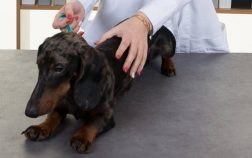Imagine the joy of bringing home a precious Dachshund puppy, eagerly awaiting the moment when those adorable eyes will peer into yours. But when exactly does this magical transformation occur? In this article, we’ll take a closer look at the fascinating journey of Dachshund puppies as they transition from a world of darkness into one filled with vibrant colors and endless possibilities. Join us as we uncover the answer to the question that every Dachshund owner has asked themselves: when do these delightful puppies open their eyes?
Week 1: The First Signs of Awareness
The importance of puppies’ eyes opening
The opening of a dachshund puppy’s eyes is an exciting milestone in their early development. It marks the beginning of their visual perception and understanding of the world around them. The ability to see allows them to connect with their environment, their littermates, and their mother. It is through their eyes that they start to navigate their surroundings and interact with their human caregivers. The opening of their eyes is a crucial step in their journey towards independence and becoming fully aware of their surroundings.
Development of the eye structures in the first week
During the first week of a dachshund puppy’s life, their eyes are still closed, and their visual development is limited. However, behind closed eyelids, significant progress is taking place. The eye structures are rapidly developing, including the optic nerves, retinas, and lenses. These structures are essential for proper vision and will continue to develop and mature in the coming weeks. While the puppies may not be able to see yet, their eyes are laying the foundation for their visual capabilities.
When dachshund puppies usually open their eyes
Dachshund puppies typically start to open their eyes around the end of their first week of life. However, it’s important to note that every puppy is unique, and individual variations in the timing of eye opening are normal. Some puppies may start to open their eyes a day or two earlier or later than others. It’s crucial for pet owners to be patient and allow their puppies to open their eyes at their own pace. Rushing the process or trying to force their eyes open can be harmful and may cause injury or infection.

Variations in the timing of eye opening
While dachshund puppies generally open their eyes around the end of their first week, there can be variations in the timing of this milestone. Factors such as genetics, breed-related characteristics, and individual differences in development can influence when a puppy opens their eyes. Additionally, environmental factors such as temperature and overall health can also play a role. It’s essential for puppy owners to be aware of these variations and to consult with a veterinarian if they have any concerns about their puppy’s eye development.
Week 2: Peeking into the World
Physical changes in puppies’ eyes during the second week
In the second week of a dachshund puppy’s life, their eyes continue to undergo significant changes. The eyelids, which were initially fused shut, gradually start to separate, allowing small gaps for glimpses of the world outside. The opening of their eyelids is a gradual process, and the size of the opening increases gradually over the course of the week. This physical change is a clear indication that their visual capabilities are progressing.
Gradual opening of the eyelids
As the puppies’ eyelids continue to separate during the second week, it’s important to resist the temptation to interfere or try to open their eyes fully. The process of opening their eyes is natural and should be allowed to happen at its own pace. Forcing the eyelids open can cause injury or discomfort to the puppies. It’s crucial to provide a safe and calm environment for their eyes to gradually open without any unnecessary disruptions.
Initial blurry vision and limited focus
Once a dachshund puppy’s eyes are partially open, their vision is still in the early stages of development. They will experience a period of blurry vision and have a limited range of focus. The world around them will appear fuzzy and indistinct. This limited vision helps protect the puppies from becoming overwhelmed by too much sensory input at once. Their eyes are gradually adjusting to the newfound ability to see, and their visual capabilities will continue to improve in the coming weeks.

Blinking reflex development
As the puppies’ eyes begin to open and they gain the ability to see, their blinking reflex also starts to develop. The blinking reflex helps to protect their delicate eyes from any irritants or foreign objects. It’s important to note that their blinking may still be uncoordinated and sporadic at this stage. Over time, their blinking reflex will become more controlled and efficient, allowing them to keep their eyes moist and free from any potential harm.
Week 3: Enhanced Visual Abilities
Clearer vision and increased focus
By the third week of their lives, dachshund puppies’ eyesight improves significantly. They can now see with greater clarity and have a wider range of focus. The world that was once blurry and indistinct becomes clearer and more defined. This improvement in visual acuity allows the puppies to observe their surroundings with greater detail and precision.
Adjustments in the puppies’ brain and visual cortex
Alongside the physical changes in their eyes, the dachshund puppies’ brain and visual cortex also undergo significant adjustments during this stage. The visual cortex is responsible for processing visual stimuli and translating them into meaningful information. As the puppies’ visual abilities enhance, their brains adapt and refine their capacity to interpret and make sense of what they see. This neurological development is vital for their overall visual perception and understanding of the world.
Exploring their surroundings through sight
With clearer vision and increased focus, dachshund puppies become more curious and start actively exploring their surroundings through sight. They will show interest in objects and people around them and may begin to follow movement with their eyes. This newfound visual exploration helps them learn about their environment, understand the dynamics of their surroundings, and further develop their cognitive abilities.
Recognition of littermates and mother
As their visual abilities continue to improve, dachshund puppies become capable of recognizing their littermates and mother more easily. They can distinguish familiar faces and bodies from those that are unfamiliar. Visual recognition plays a crucial role in their social development, as it allows them to form bonds with their siblings and mother. Through visual cues, they learn to identify their family members, understand their roles within the pack, and establish a sense of belonging.
Week 4: Eyes Wide Open
Fully developed eyes and improved visual acuity
By the fourth week, dachshund puppies’ eyes are fully developed, and their visual acuity has improved significantly. They can now see with clarity, focus, and depth perception comparable to that of adult dogs. Their eyes are fully functional and capable of capturing a wide range of visual stimuli. This milestone marks a significant step towards becoming independent individuals capable of exploring and understanding the world around them.
Ability to track moving objects
With their fully developed eyes, dachshund puppies gain the ability to track moving objects with greater precision and accuracy. Their eyes can smoothly follow the movements of toys, people, or other animals, providing them with opportunities for play and interactive learning. Tracking moving objects is an essential skill for dachshunds, as they have a strong prey drive and a natural inclination for hunting. This instinct is further honed through their visual abilities and contributes to their overall development.
Puppies relying more on vision than other senses
As their eyes fully develop, dachshund puppies gradually begin to rely more on their vision than their other senses. They start to interpret and make sense of the world predominantly through visual cues. This reliance on vision is natural and essential for their survival and growth. Their eyes provide them with valuable information about their environment, potential dangers, and opportunities for exploration.
Introduction to basic training and socialization
With their eyes wide open and their visual acuity improved, the fourth week is an ideal time to introduce dachshund puppies to basic training and socialization. Their ability to see and understand commands or cues enables them to start learning basic obedience skills. Using visual signals, such as hand movements or gestures, can aid in their training and help establish a strong bond between the puppies and their human caregivers. This early exposure to training and socialization sets the foundation for their future development and behavior.
Week 5 and Beyond: Continued Visual Development
Refinement of visual skills
Beyond the fourth week, dachshund puppies’ visual development continues to refine and sharpen. With each passing week, their visual skills become more polished, and they become increasingly adept at navigating their surroundings through sight. Their ability to recognize objects, people, and animals becomes even more accurate, allowing them to differentiate between various stimuli with greater precision.
Color perception and depth perception
As dachshund puppies progress in their visual development, they start to develop color perception and depth perception. The world that was once seen in black and white gradually gains vibrancy and richness of hues. They can distinguish between different colors, which adds another layer of information to their perception of the environment. Additionally, their improved depth perception allows them to better judge distances and spatial relationships, enhancing their overall coordination and motor skills.
Puppies’ eyes resembling those of adult dachshunds
By the fifth week and beyond, dachshund puppies’ eyes closely resemble those of adult dachshunds. The shape, color, and overall appearance of their eyes become more characteristic of the breed. This transformation reflects their journey from helpless newborns to active and lively individuals with a distinct visual identity. It is a visual testament to their growth and development, symbolizing their readiness to embark on new adventures and experiences.
Ongoing exploration and learning through sight
As dachshund puppies continue to develop, their eyes remain a fundamental tool for exploration and learning. They continuously observe and absorb information from their surroundings, helping them build a comprehensive understanding of the world. Through visual stimuli, they learn about spatial relationships, social cues, and the behaviors of other animals and humans. This ongoing exploration and learning through sight contribute to their cognitive development and lay the groundwork for their future experiences.
Factors Affecting Eye Opening
Genetics and breed-related variations
Genetics play a significant role in the timing of dachshund puppies’ eye opening. Different breeds have their own unique set of characteristics and development timelines, including eye maturation. It’s essential to recognize that breed-related variations can influence when a dachshund puppy opens their eyes. Being familiar with these variations can help pet owners better understand and anticipate the timing of this crucial milestone.
Temperature and environmental factors
Temperature and environmental factors can also affect the timing of a dachshund puppy’s eye opening. Puppies require a warm and safe environment to thrive and develop properly. Exposure to cold temperatures or harsh weather conditions may delay their eye opening. It’s important to ensure that the puppies are kept in a comfortable and suitable environment, allowing their eyes to open naturally and without any complications.
Individual differences in development
Just like human babies, dachshund puppies have individual differences in their development. Some may reach the milestone of eye opening earlier or later than others in the same litter. These individual differences can be influenced by various factors, including genetics, overall health, and the puppies’ unique growth trajectory. It’s important for pet owners to be patient and allow each puppy to reach this milestone at their own pace.
Potential complications and concerns
Although the opening of a dachshund puppy’s eyes is a natural process, there might be situations where complications or concerns arise. Some puppies may experience delayed eye opening due to underlying health issues or developmental abnormalities. It’s crucial for pet owners to be vigilant and consult a veterinarian if they notice any abnormalities, such as redness, discharge, or excessive swelling around the eyes. Early detection and appropriate treatment are key to ensuring the puppies’ visual health and overall well-being.
Caring for Dachshund Puppies’ Eyes
Observing and inspecting the eyes regularly
To ensure the overall health and well-being of dachshund puppies’ eyes, it’s important for pet owners to observe and inspect them regularly. By doing so, any potential issues or abnormalities can be detected early on. Regular observation enables pet owners to notice any changes in eye appearance, such as redness, discharge, or swelling.
Gentle cleaning of the eye area
Dachshund puppies’ eyes are prone to accumulating dirt, debris, or discharge, which can lead to discomfort or eye irritations. It’s important to gently clean the eye area using a soft, damp cloth or cotton ball. Care should be taken not to touch or rub the delicate eye structures directly. Regular and gentle cleaning helps maintain eye hygiene and reduces the risk of infection or irritations.
Preventing eye infections and irritations
Proper eye hygiene is crucial in preventing eye infections and irritations in dachshund puppies. Regular cleaning, as mentioned earlier, is one way to minimize the risk. Additionally, avoiding exposure to potential irritants, such as chemicals or smoke, can help prevent eye discomfort and infections. It’s important to create a clean and safe environment for the puppies, ensuring that their eyes are protected from potential hazards.
Consulting a veterinarian for any concerns
If pet owners have any concerns or notice any abnormalities related to their dachshund puppies’ eyes, it’s essential to consult a veterinarian. A qualified professional can assess the puppies’ eye health, diagnose any underlying issues, and provide appropriate treatment if necessary. Regular veterinary check-ups are also recommended to ensure the ongoing visual health and development of the puppies.
The Importance of Early Visual Stimulation
Benefits of visual stimulation for healthy development
Early visual stimulation plays a vital role in the healthy development of dachshund puppies. Visual stimuli help activate their brain, promote the growth of neural connections, and enhance their overall cognitive abilities. Engaging the puppies’ visual senses early on sets the foundation for their future learning and problem-solving skills. Visual stimulation also contributes to their socialization, as they learn to recognize and respond to different visual cues from their environment and human caregivers.
Introducing various visual stimuli to the puppies
To provide effective visual stimulation, pet owners can introduce various visual stimuli to dachshund puppies. This can include moving objects, colorful toys, or different patterns and textures. It’s important to ensure that the visual stimuli are safe and suitable for the puppies’ age and developmental stage. Gradually increasing the complexity and variety of visual stimuli helps keep the puppies engaged and interested, promoting their visual development and curiosity.
Enhancing visual processing and cognitive abilities
Visual stimulation helps enhance the puppies’ visual processing and cognitive abilities. By exposing them to different visual stimuli, their brains become more adept at interpreting visual information, making connections, and solving visual puzzles. This stimulation contributes to their overall mental development and helps them become more adaptable, intelligent, and responsive individuals.
Stimulating bonding and socialization
Visual stimulation not only benefits the puppies’ cognitive development but also plays a role in their bonding and socialization. Through visual cues, they learn to recognize their human caregivers and understand emotional expressions. Visual stimulation with their littermates promotes social interactions and bonding within the pack. These early bonds and social skills are essential for their lifelong relationships with humans and other animals.
Understanding Dachshund Puppy Development
Overview of general puppy development stages
Understanding dachshund puppy development is crucial for pet owners to provide appropriate care and support. Puppies go through several stages of development, including the neonatal stage, transitional stage, socialization stage, and juvenile stage. Each stage is characterized by distinct physical, behavioral, and cognitive changes. By being knowledgeable about these stages, pet owners can better anticipate their puppies’ needs and provide a nurturing environment for their growth and development.
Unique characteristics and traits of dachshund puppies
Dachshund puppies have their own set of unique characteristics and traits. They are known for their long bodies, short legs, and distinctive elongated snouts. These physical traits contribute to their specialized hunting abilities. Dachshunds are scent hounds and have a strong prey drive. Their characteristic traits and tendencies should be taken into consideration when caring for them and providing appropriate mental and physical stimulation.
Coordinating eye opening with other milestones
Eye opening is just one of the many milestones in a dachshund puppy’s overall development. It is important to note that the opening of their eyes is coordinated with other developmental milestones, such as mobility, hearing, and vocalization. As their eyes open, they gain the ability to see their environment, which facilitates their exploration, socialization, and learning experiences. Coordinating these milestones provides a holistic understanding of a dachshund puppy’s growth and development.
Preparing for the next stages of growth
As a dachshund puppy’s eyes open and their visual abilities improve, it’s important for pet owners to prepare for the next stages of their growth. This includes providing appropriate nutrition, engaging in regular exercise, and continuing with their training and socialization. It’s important to remember that a dachshund puppy’s development is ongoing and requires dedicated care and attention throughout their lifetime. By being prepared and committed, pet owners can ensure that their dachshund companion thrives and leads a happy, healthy life.
Conclusion
The journey of a dachshund puppy’s visual transformation is nothing short of remarkable. From their first signs of awareness and the opening of their eyes in the first week to their fully developed eyes and enhanced visual acuity by the fourth week, their visual capabilities undergo a significant progression. Throughout their early development, their eyes serve as a window to the world, allowing them to explore, learn, and connect with their environment and those around them. It’s essential for pet owners to provide proper care, attention, and visual stimulation to support their puppies’ visual growth and development. By appreciating the wonder and beauty of their opened eyes, pet owners can embrace the lifelong bond with their dachshund companion and embark on an exciting and fulfilling journey together.




